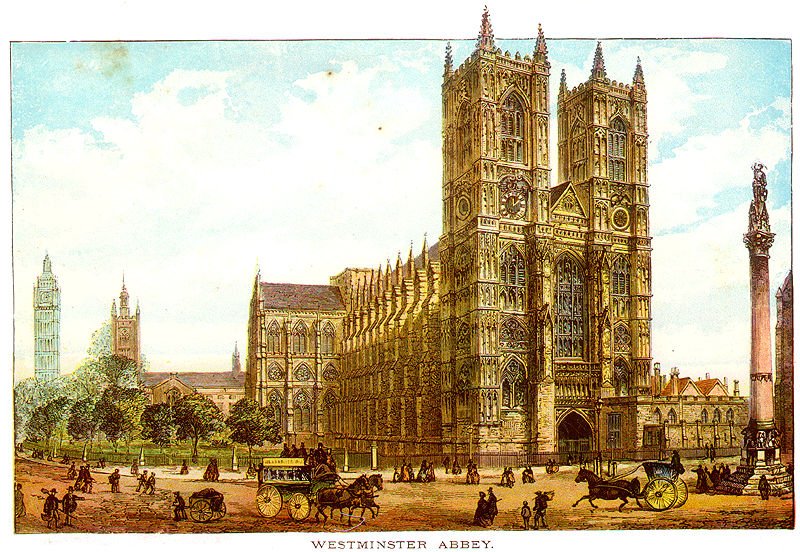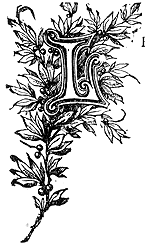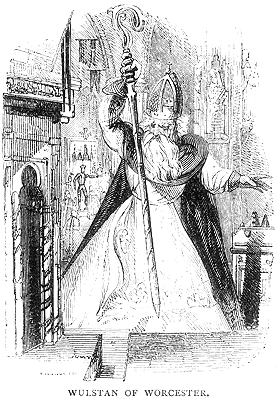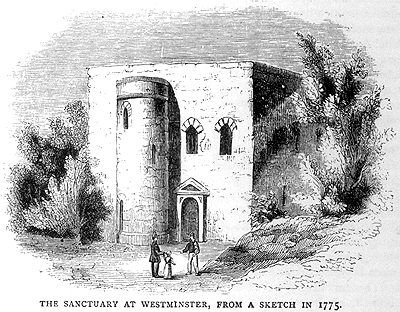In Henry VII.'s Chapel we find the very perfection of architecture. Some one has called it (architecture) "frozen music," and one understands the rather fantastic comparison as one looks at this wonderful specimen of art. The brazen gates, the exquisitely carved ceiling, the double range of windows, the brown-wainscoted stalls, with their wonderfully carved Gothic canopies, the pavement of black and white marble, Henry VII.'s tomb, all are unspeakably beautiful and stately. The Abbey is built on land that was once an island, called Thorny, from its being overgrown with thorns, and surrounded by water reeds, but it was really a peninsula of the purest sand and gravel. The Abbey has no basement storey, but is built on fine close sand, and is secured only by its very broad, wide, and spreading foundations. A pagan temple originally stood here; but Sebert, king of the East Saxons, having been converted to Christianity, pulled it down, and founded on its site a church dedicated to St. Peter. On account of the dedication of the church to the Apostle-fisherman and tutelar saint of the craft, the toilers in the sea were wont, in Popish days, to offer salmon on the high altar; the offerers having on such occasions leave to dine at the convent table, and to ask bread and ale from the cellarer. Edward the Confessor built and endowed the present Abbey, giving a tenth part of his entire substance in gold, silver, cattle, and other possessions for the purpose. The pious king lived only just long enough to see the completion of the work; the Abbey being dedicated on the Feast of the Holy innocents, December 28th, 1065, and Edward dying eight days afterwards. He was buried by his own desire in front of the high altar. A year afterwards, William the Norman was crowned in that same Abbey; and ever since our kings and queens have held their coronations there.  There is a singular legend belonging to the Abbey at this period. The Conqueror wished to replace the Saxon bishops by Normans, and for this purpose called a synod at the church in Westminster, under Archbishop Lanfranc, to examine into the conduct and qualifications of the English clergy, and to eject "such bishops as had little learning or influence." At this synod Wulstan, Bishop of Worcester, was charged with being "a most illiterate and foolish man, and unfit for the station he held; as very idiot, unacquainted with the French language, and incapable either to instruct the Church or counsel the king." Lanfranc, William's Archbishop, then demanded his pastoral staff and ring in the king's name; but the old bishop, firmly grasping his staff, replied,- "I know, my Lord Archbishop, that I am entirely unfit for, and unworthy so high a station, being undeserving of the honour, and unequal to the task; however, I think it unreasonable that you should demand that staff which I never received from you; yet in some measures I submit to your sentence, and will resign it; but I consider it just to make that resignation to King Edward, who conferred it on me."
"Thou knowest, O holy king, how unwillingly I undertook this office, and even by force; for neither the desire of the prelates, the petition of the monks, nor the voice of the nobility prevailed, till thy commands obliged me. But see-a new king, new laws, and a new bishop pronounces a new sentence. Thee they accuse of a fault for making me a bishop, and me of assurance for accepting the charge." Then, raising his arm, he put the staff erect into the carving on the tomb, left the Abbey, and resuming the dress of a monk, went and sat with the monks in the chapter house. A priest was sent by the synod for the staff, but he found it so firmly fixed in the tomb that it could not be moved. The king was told of this strange fact, and he and the archbishop both tried to remove it, but in vain. William sent for Wulfstan and ordered him to try and remove the staff. The prelate simply touched it, and it yielded at once to his hand. "Keep it," said the king; "the holy Edward will not let you resign it. Resume the charge of your see." Such implicit credence was given to this legend, that King John urged it to Pandulph, the Pope's legate, as the proof of the right of English kings to nominate a bishop. William, who, to ingratiate himself with his new subjects, displayed great veneration for the Confessor's memory, was probably quite ready to acknowledge the right of the bishop Edward had appointed after this solemn and public appeal to the monarch, who was looked on as a saint. The monuments in the Abbey form a portion of our history; for they record the names and deeds of England's greatest sons, as well as of many of her sovereigns. To have a place amongst the Abbey dead has inspired many a hero. We all know how Nelson, as he boarded the Spanish ship, cried, "Victory, or Westminster Abbey," though he, as well as his heroic contemporary, the great Duke of Wellington, rest together, not there, but in St. Paul's Cathedral. We have not space to linger over the monuments; but we must first say that beneath our feet, when standing opposite the tombs of Lord Robert Manners and Lord Chatham, lie side by side the great rival statesmen - Pitt and Fox. In Poets' Corner sleep Chaucer, Spenser, Prior, Butler, Milton, Dryden, Addison, Pope, Gay, Thompson, Goldsmith, Camp. bell, Browning, etc., etc., and a monument was here erected to Shakspeare by that noble woman, Anne, Countess of Pembroke and Montgomery. Westminster in olden times possessed the right of sanctuary; though sometimes abused by affording shelter to great criminals, it was more generally a blessed protection to the weak and helpless. Never was its sanctuary more needed than by that unhappy queen, Elizabeth Woodville, when, in 1483, she took her second little Yorkist son's hand, and led him, followed by her five daughters, into the Abbey. There, seated on the rushes, her long fair hair streaming on her shoulders, a woeful suppliant, she demanded sanctuary. It was granted to her. Rotherham, Archbishop of York, endeavouring to comfort her, delivered the Great Seal to her, saying, "Madam, be of good cheer; for I promise you, if they crown any other king than your son whom they have now with them, we shall on the morrow crown his brother whom you have with you." In fact, the life of each child was safe so long as they were apart. But Gloucester suffered no obstacle in his path. He sent the Cardinal Archbishop of Canterbury to claim little York. "Children had no right of sanctuary," he said, "and the prince must be present at the coronation." The agony of the queen was terrible when her little York was thus demanded. The Archbishop was much distressed himself, but he was powerless to defend her against the might and will of the Protector. It was probably the sense of the uselessness of her own resistance, also, that caused the queen to yield at last. Taking her son by the hand, she said solemnly, "My lord, and all my lords now present, I will not be so suspicious as to mistrust your truth. Lo, here is this gentleman, whom I doubt not would be safely kept by me if I were permitted; and well do I know there be such deadly enemies to my blood, that if they wist where any lay, they would let it out if they could. The desire of a kingdom knoweth no kindred; brothers have been brothers' bane; and may the nephews be sure of the uncle? Each of these children is safe while the pair are asunder. Notwithstanding, I have delivered him (and his brother's life with him) into your hands, and of you I shall require them before God and man. . . . Farewell, my own sweet son. God send you good keeping. Let me kiss you once ere you go, for God knoweth when we shall kiss together again." Tenderly embracing the poor boy, she parted from him, "weeping bitterly over him, and he weeping as fast in his turn." 1 Thus Richard of York is said to have passed to his doom in the Tower. In Westminster Abbey our kings and queens are crowned; and since Edward I. brought the famous coronation chair from Scone, they have received the royal diadem seated on the magic stone, that he, Edward, so vainly strove to render impotent. For the coronation chair has a legend attached to it of a very singular nature. The stone in the seat is said to be the same on which Jacob rested his head when he was a wanderer at Bethel, and saw the vision of angels. It was taken to Ireland and afterwards to Scotland, where it was used, as it still is, as the seat of coronation, for on the stone is an inscription in Runic characters, running thus, we are told:- Strangely enough, the kings of Scotland have actually followed their Chair and the Stone of Destiny; James VI. of Scotland ultimately inheriting the crown of the sovereign who had carried off the Stone to do away with the Scotch superstition. A great many of our kings have been buried at Westminster. For a long time the place of sepulture of James I. was unknown, but it was found at last that he had taken his last rest in the grave of Henry VII. The grave of his mother, i.e., Mary Queen of Scots - has given shelter to many of her royal kin, amongst them the unfortunate Lady Arabella Stuart. The tombs in Westminster Abbey suggested a charming essay to Addison, and will yield much matter for reflection to a visitor of the present century. * * * * * * 1. This is, perhaps, the saddest scene the stately Abbey ever witnessed. |
||||

 Then the stately old bishop rose, and leaving the synod, crossed the church and stood by Edward's tomb, saying,-
Then the stately old bishop rose, and leaving the synod, crossed the church and stood by Edward's tomb, saying,-